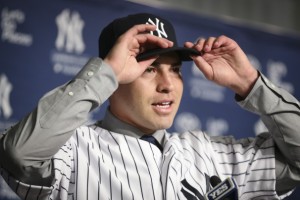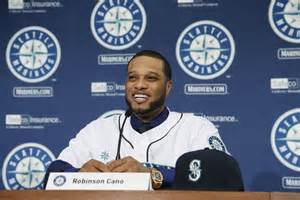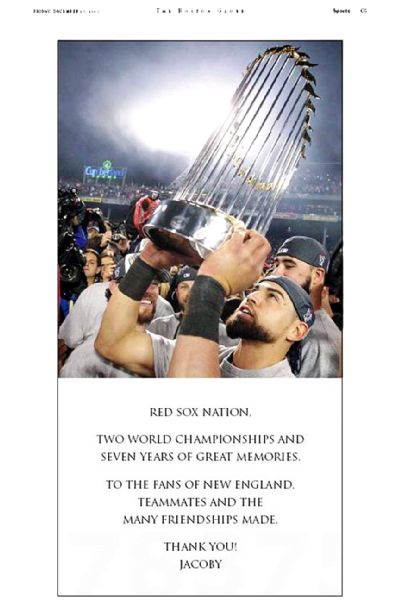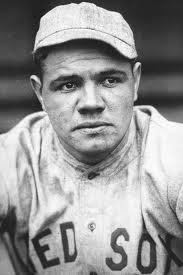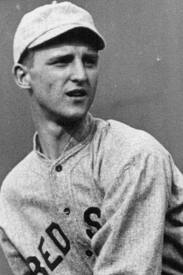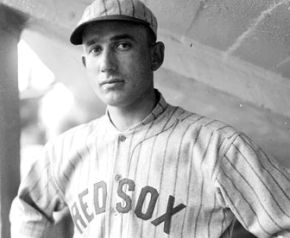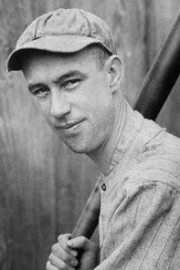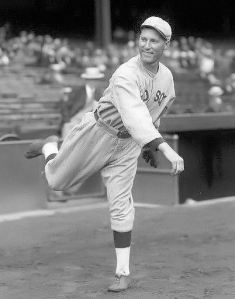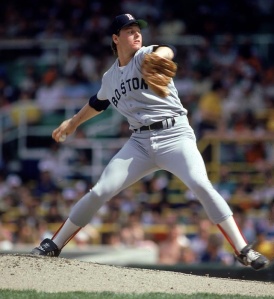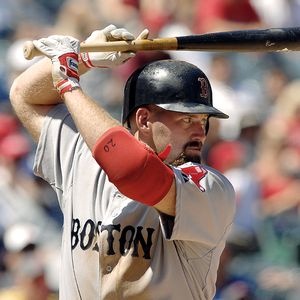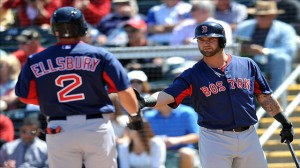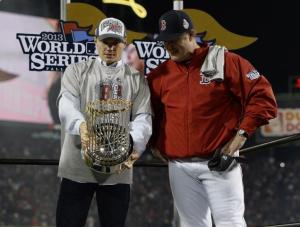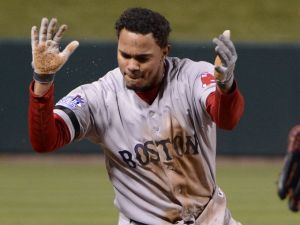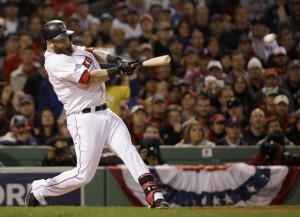Tagged: Jacoby Ellsbury
MLB’s Hot Stove spending could eclipse $2 billion
No sport incites salary rage like Major League Baseball, so for those who bellyache the money is too big, consider this a fair warning to gulp a handful of Tums before reading the next sentence.
Teams are barreling toward $2 billion spent on free agents this offseason.
Now, they may fall short of that nice, round number and still absolutely obliterate the previous spending record: around $1.75 billion in the 2006 offseason, a number that includes major league free agents as well as the posting fees for Daisuke Matsuzaka and Kei Igawa.
Already teams have lavished approximately $1.543 billion on players, the latest a $130 million investment by the Texas Rangers for seven years of outfielder Shin-Soo Choo. He is the third nine-figure player of the offseason, joining Jacoby Ellsbury ($153 million) as an offset diamond around the center stone, Robinson Cano ($240 million).
 There is plenty more to come. If Japanese pitcher Masahiro Tanaka gets posted – his status remains in limbo – the $2 billion threshold is certain to be obliterated. Between his contract and the $20 million posting fee, teams expect to pay somewhere in the neighborhood of $120 million for Tanaka. Beyond him are three pitchers who reason says will cash in for around $60 million each (Ervin Santana, Ubaldo Jimenez and Matt Garza), an outfielder worth the same (Nelson Cruz), a shortstop a notch down from that (Stephen Drew), another starter sure to get multiple years (Bronson Arroyo), a bevy of relievers who will get papered (Fernando Rodney, Grant Balfour and Jesse Crain, among others) and the dregs of the class, who can fetch $5 million here, $3 million there and add up quickly.
There is plenty more to come. If Japanese pitcher Masahiro Tanaka gets posted – his status remains in limbo – the $2 billion threshold is certain to be obliterated. Between his contract and the $20 million posting fee, teams expect to pay somewhere in the neighborhood of $120 million for Tanaka. Beyond him are three pitchers who reason says will cash in for around $60 million each (Ervin Santana, Ubaldo Jimenez and Matt Garza), an outfielder worth the same (Nelson Cruz), a shortstop a notch down from that (Stephen Drew), another starter sure to get multiple years (Bronson Arroyo), a bevy of relievers who will get papered (Fernando Rodney, Grant Balfour and Jesse Crain, among others) and the dregs of the class, who can fetch $5 million here, $3 million there and add up quickly.
For those surprised, don’t be. Baseball’s economic system, as presently constituted, guaranteed free-agent salaries ballooning to unfathomable levels. A number of factors conspired to turn it into even more of a money booth than in the past.
First are the revenues. Back in 2006, a year before the recession started, baseball’s revenues were around $5.5 billion. Today, they are nearly $8.5 billion. And only now is free-agent spending catching up; over the previous three offseasons, it fell somewhere in the $1.3 billion to $1.4 billion range.
More than that are the mechanisms in place that more or less force teams to spend their money on free agents. Simply put: They can’t spend it anywhere else. The league capped how much teams can spend on the draft and international free agents. Many of the best players in the game don’t even make $1 million a season because the system artificially depresses salaries for the first three years of a career. Plenty of the best would-be free agents forgo the open market by signing long-term extensions, which can be for big money, sure, but almost every time represent a discount against what the player would receive with his services available to all 30 teams.
For those, then, with the patience to wait for free agency and the luck to do so coming off even a decent walk year, the rewards are massive – enough so to make you wonder if there will be some sort of a market correction in which pre-free-agency extensions start to inch closer to the open market or players who might’ve been locked up opt instead to chance free agency.
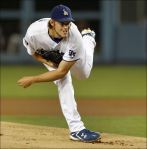 There is an expectation within the industry that at least a couple of the monster class of free-agent pitchers next offseason will sign extensions. The group includes Clayton Kershaw (who will command the first deal for a pitcher over $200 million), Max Scherzer, Jon Lester, James Shields, Homer Bailey and Justin Masterson. If each went to free agency, there’s a good three-quarters of a billion dollars among the six, more than making up for a hitting class that includes Hanley Ramirez and a group that is best referred to as Et Cetera.
There is an expectation within the industry that at least a couple of the monster class of free-agent pitchers next offseason will sign extensions. The group includes Clayton Kershaw (who will command the first deal for a pitcher over $200 million), Max Scherzer, Jon Lester, James Shields, Homer Bailey and Justin Masterson. If each went to free agency, there’s a good three-quarters of a billion dollars among the six, more than making up for a hitting class that includes Hanley Ramirez and a group that is best referred to as Et Cetera.
It’s one of the biggest reasons the Rangers went so hard after Choo, giving him more years and money than they wanted: the outfield market next year is paltry, and they’ve got goo-gobs of TV money from local and national sources to cover it. Give the Rangers this much: They’ve long made a habit of being ahead of other teams in how they spend their money. They went bigger in Latin America than any other team before the spending cap, then blew by it when the penalties weren’t as severe as they are now. This offseason, they’ve committed more than a quarter billion dollars to Choo and Prince Fielder and helped spearhead the spending that left the American League West as baseball’s most munificent division and the AL spending nearly three times as much as its National League counterparts.
The five AL West teams have combined to heap $466.6 million on free agents – Cano and Choo account for 79.2 percent of that – while the AL East is at $399.25 million (with the Yankees at 79.1 percent of that). Next is the AL Central ($268.75 million), followed by the three NL divisions: East ($182.98 million), West ($148.25 million, not including the Hunter Pence or Tim Lincecum deals because they signed before free agency) and Central ($77.95 million – and, without Jhonny Peralta, less than $25 million combined).
Thirteen players by themselves have signed for $25 million, and another seven have exceeded the $20 million mark. It’s almost exactly like 2006, with 15 at $25 million-plus and 20 at $20 million-plus. With the five starters, Cruz and Drew left to go, this year’s numbers should dwarf ’06 in all respects.
Welcome to baseball in 2014, which rewards free agency more than ever. Ask Robinson Cano. Ask Jacoby Ellsbury. Ask Shin-Soo Choo. Ask any of the middle relievers cashing in for $6 million a year, the back-end starters and utilitymen getting four-year guarantees, the fourth outfielders getting paid what used to be All-Star wages. The union sought free agency with such fervor 40 years ago because the brilliant men leading it saw this day, when owners would make money hand over fist and give players their fair share.
Even those brilliant men could not fathom just how big that number would be: $2 billion or bust.
You’re Welcome…..
On the day he will be introduced as the newest New York Yankee, outfielder Jacoby Ellsbury took out a full-page ad in the Boston Globe to thank Red Sox fans for seven years of “great memories.”
Ellsbury, fresh off winning his second World Series ring with the Red Sox, agreed to a $153 million deal with New York last week. The contract includes a $21 million team option for the 2021 season, with a $5 million buyout. If the option is exercised, the deal would be worth $169 million over eight years.
Jacoby will wear No. 22 with the Yankees, (he wore No. 2 with the Red Sox, but obviously that belongs to Yankees captain Derek Jeter) taking over the number of Roger Clemens, another Boston Red Sox star who moved south to New York.
Ellsbury, who turned 30 in September, led the majors with 52 stolen bases despite being hobbled late in the season by a broken right foot. The lefty-hitting leadoff man batted .298 with nine homers and 53 RBIs, and the short right-field porch at Yankee Stadium should boost his power numbers.
He is part of a rebuilding plan by the Yankees, who lost All-Star second baseman to Seattle. New York also agreed to deals with catcher Brian McCann and outfielder Carlos Beltran.
Curse..? Bambino..? What is it you speak of?
Jacoby Ellsbury is just the latest in a long line of Red Sox who have defected (or been shipped to… let’s be fair) to the Bronx.
Yes, Babe Ruth is most famous and spawned the 86 year ‘curse’ that generations of New Englanders swore would (and in many cases did) outlive them. But to be quite serious and objective… The Babe was hardly alone.
Herb Pennock: Somewhat overshadowed by his corpulent teammate (see above), the Hall of Fame lefty went from serviceable starter with the Sawx to an ace for a Bombers ballclub that won its first World Series title in 1923 … and a few more after that.
Sad Sam Jones: Jones, dealt to Boston for Hall of Famer Tris Speaker, won 23 games for the Sox in 1921. So of course that December he was traded to the Yankees. Jones had a bumpy ride in the Bronx, but he did post 21 wins and a no-hitter for the 1923 champs.
Joe Dugan: Boston shipped Jumping Joe to New York midway through the 1922 season, and there he helped the Yanks win their second AL pennant. He’d play in five World Series in pinstripes overall. (The Bombers won three of them.)
Waite Hoyt: In case you thought the ’20s weren’t rough enough for Red Sox fans, this Hall of Fame hurler joined the Yanks in 1921 after two seasons in Boston, averaging 18 wins over the next eight seasons and winning a league-high 22 games for the famed ’27 Bombers.
Red Ruffing: Ruffing lost 20-plus games two years in a row for the Red Sox in 1928 and ’29 — then won 20 or more for the Yankees in four straight seasons, starting in 1936, en route to the Hall of Fame.
Sparky Lyle: Lyle won a Cy Young in 1977 and played on two Yankees title teams. The guys the Bombers traded for him? Danny Cater and Mario Guerrero, who hit a collective .252 in Boston and never played more than 93 games in any of their seasons with the Sox.
Luis Tiant: Unlike the previous players on our list, Tiant joined the Yankees in the twilight of his career, winning 21 games in two seasons in the Bronx (1979 and ’80) after spending several years as the ace of the Red Sox.
Wade Boggs: Boggs put up most of his numbers in Boston, but when it came time for the Hall of Fame third baseman to finally win a title, he did it in the Bronx — famously riding around Yankee Stadium on a horse in 1996.
Roger Clemens: Rocket won three Cy Young Awards in Boston, compared to just one with the Yankees. But two World Series titles (in 1999 and 2000) in the Bronx more than made up for it.
Tom Gordon: Flash became a folk hero in Boston as a starter turned All-Star closer in 1998. He even helped inspire a Stephen King novel, “The Girl Who Loved Tom Gordon.” Did that girl become a Yankees fan when he joined the Bombers’ bullpen six years later?
Doug Mientkiewicz: Eye Chart’s career doesn’t stack up against many of the players on our list, but when the Red Sox finally won a title in 2004, he was the toast of Beantown. The Yanks picked him up in 2007 after he’d had season-long stints with the Mets and Royals.
Johnny Damon: The Caveman tormented the Yanks while a Sox star on the ’04 champs — then crushed Boston fans when he went clean-shaven and signed with the Bombers in 2006. His baserunning heroics in the 2009 World Series won’t soon be forgotten, by either fan base.
Derek Lowe: Lowe was the winning pitcher in Game 7 of the 2004 ALCS, helping the Sox break the Bambino’s curse. After pitching for the Dodgers, Braves and Indians, Lowe signed with the Yankees midway through the 2012 season.
Kevin Youkilis: Youk became a Yank prior to the 2013 season, but a back injury limited The Greek God of Walks to just 28 games (and eight bases on balls, if you’re scoring at home).
Don’t Let The Door Hit Ya’…
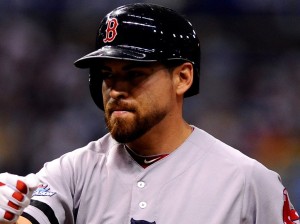 The New York Yankees made it official Saturday, announcing the completion of a seven-year deal with free-agent outfielder Jacoby Ellsbury and a one-year contract for returning starter Hiroki Kuroda.
The New York Yankees made it official Saturday, announcing the completion of a seven-year deal with free-agent outfielder Jacoby Ellsbury and a one-year contract for returning starter Hiroki Kuroda.
The busy Bronx Bombers have been undergoing a pricey roster overhaul after missing the playoffs for only the second time in 19 years.
Ellsbury, fresh off winning the World Series with Boston, agreed to a $153 million deal with New York on Tuesday. The contract includes a $21 million team option for the 2021 season, with a $5 million buyout. If the option is exercised, the deal would be worth $169 million over eight years.
The Yankees will hold an introductory news conference for Ellsbury at Yankee Stadium on Friday.
Ellsbury, who turned 30 in September, led the majors with 52 stolen bases despite being hobbled late in the season by a broken right foot. The lefty-hitting leadoff man batted .298 with nine homers and 53 RBIs, and the short right-field porch at Yankee Stadium should boost his power numbers.
He joins a crowded outfield that will include Carlos Beltran, who agreed to a three-year, $45 million contract, according to two people familiar with the deal, on Friday. Beltran’s agreement came hours after All-Star second baseman Robinson Cano decided to leave for Seattle.
Whoo-pee!
Free-agent outfielder Carlos Beltran has agreed to a three-year, $45 million deal with the New York Yankees, sources confirmed to ESPN.com on Friday night.
Beltran, 36, hit .296 with 24 home runs and 84 RBIs in 145 games this past season for the NL champion St. Louis Cardinals.
Beltran took $3 million less to sign with the Yankees, sources told ESPNNewYork.com’s Andrew Marchand. Beltran had an offer for three years and $48 million with another club. A source with knowledge of those discussions said Beltran was “down the road” with that team.
Beltran met with the Arizona Diamondbacks in Phoenix earlier this week, when the team made a three-year offer exceeding $45 million, The Arizona Republic reported Friday.
The Kansas City Royals, Beltran’s first major league team, also pursued him. But the Royals filled their outfield void with a trade for Milwaukee’s Norichika Aoki on Thursday.
The Yankees had sent out signals that they wouldn’t be willing to go to three years on a deal for Beltran, but they relented to get an agreement done in advance of the winter meetings, which begin Monday in Orlando, Fla. The pact with Beltran, which comes on the same day former Yankees second baseman Robinson Cano agreed to a 10-year, $240 million deal with the Seattle Mariners, marks the latest addition to a revamped lineup in the Bronx.
Beltran and fellow free-agent signings Jacoby Ellsbury and Brian McCann will give manager Joe Girardi a decidedly new batting order for a total long-term cost of $283 million.
A Huge Log on the Hot Stove….
Wednesday night’s huge (what other word do you use for a transaction involving Prince Fielder?) deal between the Detroit Tigers and Texas Rangers — Fielder to Texas, Ian Kinsler to Detroit — could have a ripple effect on the Red Sox.
For one, it may take the Rangers out of the bidding for free agent first baseman Mike Napoli, although it’s still conceivable that the Rangers view Napoli as an ideal complementary bat to the left-handed hitting Fielder, who could DH while Napoli plays first. The Rangers ranked 14th in the league in OPS at first base (.700) — only the Yankees were worse — and they were slightly worse at DH (.698, ninth in the league).
Less than two years after boldly signing Prince Fielder to a $214 million contract, the Detroit Tigers traded the slugging first baseman to Texas in another blockbuster move.
Fielder was dealt to the Rangers on Wednesday night for second baseman Ian Kinsler. The Tigers agreed to pay the Rangers $30 million as part of the swap, according to a person with knowledge of the deal. The person spoke on condition of anonymity because the amount of money exchanged was not revealed when the teams announced the trade. The $30 million is payable from 2016-20.
”Obviously, a very exciting trade for us in adding Prince Fielder to the organization,” Rangers general manager Jon Daniels said. ”Also a tough trade to make in that Ian Kinsler’s been with the organization since he was drafted in ’03, and we’ve signed him here a couple of times. Been here, a catalyst for our World Series clubs, and a huge part of this. A winning guy, a heart-and-soul guy, and Detroit got a tremendous player and person.”
The Tigers, meanwhile, made it known last week at the GM meetings that contrary to speculation, they are not in the market for Ellsbury. Moving Fielder wouldn’t seem to alter that. The Tigers’ priroities remain re-signing pitcher Max Scherzer and extending two-time MVP Miguel Cabrera, whose current deal runs out after the 2015 season.
It’s the first headline-grabbing move of baseball’s offseason, and it involves two of the American League’s top teams. Detroit has won three consecutive AL Central titles and reached the World Series in 2012, while Texas won the AL pennant in 2010 and 2011.
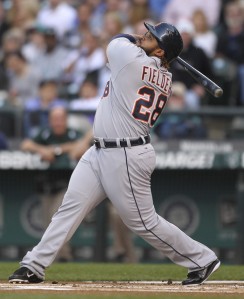 Fielder, a five-time All-Star, had to consent to the trade before it could be completed. The big first baseman signed a $214 million, nine-year contract with the Tigers before the 2012 season that includes a limited no-trade provision.
Fielder, a five-time All-Star, had to consent to the trade before it could be completed. The big first baseman signed a $214 million, nine-year contract with the Tigers before the 2012 season that includes a limited no-trade provision.
”We’re thankful for what he did for us,” Detroit general manager Dave Dombrowski said. ”It’ll be a bat that we miss at times – there’s no doubt about it.”
Kinsler just finished the first season of a $75 million, five-year contract.
With stars like Fielder, Justin Verlander, Miguel Cabrera and Anibal Sanchez in the fold, Detroit’s payroll had become one of the game’s biggest. And although Fielder hit 55 home runs over the last two years for the Tigers, his numbers dipped this season and he struggled in the playoffs when Detroit lost to Boston in the AL championship series.
Fielder hit .279 with 25 homers this year. He drove in 106 runs, but it was his lowest home run total over a full season. He did not have a single RBI in the 2013 postseason and hit .182 in the ALCS.
Daniels said the trade came together quickly – the first discussions took place Tuesday. The Rangers will welcome the durable Fielder, who has played 162 games in four of the last five seasons. Texas was interested in Fielder when he signed with Detroit as a free agent.
”Our offer was well below what it ended up being, so we weren’t that close,” Daniels said. ”I thought he was a genuine guy that really loved the game, really loved playing the game, loved his boys, his sons.”
Kinsler batted .277 with 13 homers this year. The a three-time All -Star was limited to 136 games because of injuries to his ribs and right side. Kinsler stole 15 bases in 2013 – not a high total by his standards but more than any player on the Detroit team he is joining.
-Star was limited to 136 games because of injuries to his ribs and right side. Kinsler stole 15 bases in 2013 – not a high total by his standards but more than any player on the Detroit team he is joining.
The trade could save the Tigers more than $75 million in the long run, giving them more financial flexibility with Cy Young Award winner Max Scherzer a year from free agency.
Fielder is still only 29, and the Rangers are set to add a big bat to the middle of their lineup while also resolving a logjam in the middle of their infield. Jurickson Profar, a highly touted 20-year-old prospect, appeared to be blocked by Kinsler and shortstop Elvis Andrus. Now, Profar should have a chance to play regularly.
The Tigers signed Fielder to a huge contract shortly before spring training in 2012 – after designated hitter Victor Martinez injured his knee. Martinez came back in 2013. With Fielder gone, Cabrera may move from third base back to first.
”I’m really not sure what we’re going to do as we sit here now today,” Dombrowski said. ”Eventually, we see him as a first baseman. Will it happen this year or not? I’m not sure.”
The 31-year-old Kinsler fills a need at second base for Detroit after Omar Infante became a free agent.
Fielder is due $168 million through 2020, a salary of $24 million per season. Under his no-trade clause, he submits a list of 10 teams each year that he can be traded to without his approval.
Texas was not on that list this year, but Fielder agreed to accept the trade and instructed agent Scott Boras to approve the deal.
”If he was coming off the best year of his career, he’s not available,” Daniels said. ”I think that’s kind of the whole idea of this deal – if anybody feels like that’s a sign of things to come, that he’s slipping, you may not like the deal. We don’t feel that way. We don’t feel that way at all.”
Kinsler is guaranteed $62 million through 2017: $16 million in each of the next two seasons, $14 million in 2016, $11 million in 2017 and a $5 million buyout of a $10 million option.
It’s already been an unpredictable offseason for the Tigers. Manager Jim Leyland stepped down after the season and was replaced by Brad Ausmus. Detroit could have come back with a similar roster and probably been favored to win the division again, but now more changes seem possible.
”If you put Kinsler’s bat at the top of the lineup, that’s an instant threat,” Ausmus said. ”It changes the dynamic, but it doesn’t mean it’s any less potent.”
If Cabrera moves back to first base, prospect Nick Castellanos might replace him at third. Previously, it appeared Castellanos would have to play the outfield if both Cabrera and Fielder were still on the team.
Andy Dirks is still available to play left field, but that’s a spot the Tigers could still try to upgrade. They also have six capable starting pitchers – Drew Smyly was used in the bullpen this year – so that’s a surplus that could come in handy in a possible trade.
Detroit’s bullpen will likely undergo a makeover after struggling last season.
The Rangers lost slugging outfielder Nelson Cruz to a late-season suspension as a result of MLB’s investigation in the Biogenesis case. He’s now a free agent, and if Texas loses him, Fielder, who hit 50 homers in 2007 for Milwaukee at 23, should help replace his production.
”A huge focus for us this winter was finding some kind of middle-of-the-order presence and power, and at 29 years old, I still think there’s still a lot of big run production and years ahead of him,” Daniels said.
The Rangers also were thought to be on the margins for free agent outfielder Jacoby Ellsbury, but taking a contract that pays Fielder $24 million a year through the 2020 season would seemingly be a deterrent to GM Jon Daniels adding another $20-million-plus per year in Ellsbury. The Rangers have two outstanding outfield defenders in Leonys Martin and Craig Gentry, so it would seem they would be better served going after catcher Brian McCann.
Adrian Beltre and Alex Rios are among the dangerous hitters under contract next season in Texas. Beltre had an AL-high 199 hits and Rios, acquired from the Chicago White Sox in August after Cruz was suspended, has a year left on his deal.
The Rangers lost a one-game tiebreaker to Tampa Bay for the second AL wild card this year.
A Line In The Sand…?
Red Sox GM figures to stick with winning formula from last offseason
By Gordon Edes | ESPNBoston.com
It’s appropriate that both the general managers meetings that open Monday in Orlando and the winter meetings that commence in the same locale about a month later are within jogging distance of Fantasyland.
Thirty teams are dreaming big, although it remains to be seen whether the model adopted by the Boston Red Sox last winter — eschewing the biggest prizes on the market for lesser, complementary pieces — will be embraced by other clubs seeking to emulate the extraordinary strides made by the Sox in one dizzying worst-to-first leap.
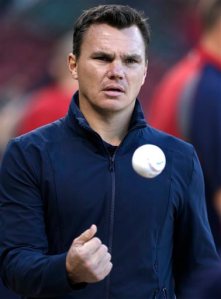 Of more interest to Red Sox fans, of course, is whether GM Ben Cherington will remain faithful this winter to the philosophy of modest moves that worked wonders for him last year (it was a year ago Sunday that the Sox came to terms with the first piece of their puzzle, catcher David Ross, followed 11 days later by the signing of outfielder Jonny Gomes, the first moves in the rebuilding) or will succumb to the budget-be-damned impulse the Sox have followed in past years.
Of more interest to Red Sox fans, of course, is whether GM Ben Cherington will remain faithful this winter to the philosophy of modest moves that worked wonders for him last year (it was a year ago Sunday that the Sox came to terms with the first piece of their puzzle, catcher David Ross, followed 11 days later by the signing of outfielder Jonny Gomes, the first moves in the rebuilding) or will succumb to the budget-be-damned impulse the Sox have followed in past years.
What makes that discussion especially relevant in the coming weeks is that some of the players so vital to the Sox’s success this season — most notably Jacoby Ellsbury and Mike Napoli — are among the free agents expected to reap some of this winter’s greatest financial rewards.
By this point, it should be widely understood that Ellsbury is not coming back to Boston unless the Sox make an exception and sign him for top-of-the-market years and dollars. Agent Scott Boras will make the most of market precedents the Sox themselves helped to establish when they gave Carl Crawford a seven-year, $142 million deal three years ago. Someone will give Ellsbury that kind of money; it’s very doubtful it will be Boston. (Let him walk. He’s already proven injury prone and is obviously on the wrong side of 30. The Sox can more easily find a stop-gap to platoon with Shane Victorino if they feel Jackie Bradley Jr. needs more time.)
Napoli, however, would seem to be a candidate to fall within the kind of parameters the Sox set last winter, when they showed a willingness to overpay in terms of dollars in exchange for shorter years. The Sox struck such a deal with Napoli on the first day of the winter meetings in 2012, coming to terms on a three-year, $39 million deal, which subsequently blew up when Napoli failed his physical because of a degenerative hip condition.
Napoli’s performance this season, when the hip condition did not surface as an issue, would seem to put him in line for, at minimum, a similar deal this winter. It should also work in Boston’s favor that he appears so eager to return.
(Personally, I’d rather see the Sox sign Nap to a 2 year deal with roughly $26 million plus incentives and fulfill the original 3 year proposed deal than sign him to additional years based off a performance year already in the books.)
Napoli and Ellsbury both received qualifying offers of $14.1 million from the Red Sox, which places Boston in line to receive a first-round draft pick as compensation if they sign elsewhere. Shortstop Stephen Drew received a similar offer; all three players have until 5 o’clock Monday to accept a qualifying offer, which would make them a signed player for 2014.
None is expected to do so, as all three players figure to have other suitors. Teams interested in Ellsbury will not be stalled by the loss of a compensatory first-rounder; that also figures to be the case with Napoli, one of the few power bats on the market. Drew could prove to be a more interesting case, although he should benefit from a soft free-agent market at his position.
Catcher Jarrod Saltalamacchia, also a free agent, did not get a qualifying offer, for the simple reason the Sox didn’t want to risk him accepting it, placing him at a salary level they have little interest in paying him. That should not be interpreted, however, as the Sox deciding against bringing Saltalamacchia back.
The most attractive free-agent catching option is Brian McCann, late of the Atlanta Braves, but he will come at a much higher price than Saltalamacchia would and will require more years. The Sox are looking for a bridge to take them to their catcher of the future — Blake Swihart, perhaps in some combination with Christian Vazquez — so signing McCann for four or more years, while also having to surrender a first-round draft pick, would seem to be a questionable proposition.
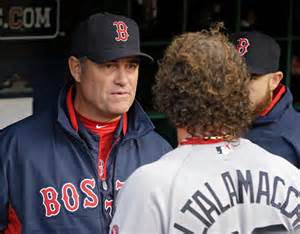 Saltalamacchia had 54 extra-base hits last season, including 40 doubles (a club record for catchers), and an .804 OPS. On the defensive side, he made noticeable strides, even though John Farrell opted for his better defender, Ross, in the World Series, a decision made easier by Saltalamacchia’s October slump. His return, while not assured, is eminently plausible.
Saltalamacchia had 54 extra-base hits last season, including 40 doubles (a club record for catchers), and an .804 OPS. On the defensive side, he made noticeable strides, even though John Farrell opted for his better defender, Ross, in the World Series, a decision made easier by Saltalamacchia’s October slump. His return, while not assured, is eminently plausible.
(Agreed. Salty would be a better choice for a two to three year pick-up, based off the lesser money and the fact he’ll still be fairly young should the Sox decide to trade him before the expiration of the contract. Between he and Ross there is a great tandem of experience to spell the big club till the youngsters are more seasoned. Though young and on the upswing, Jarrod has difficulty hitting outside of Fenway and that should limit his suitors.)
On the trading front, Cherington can expect to field inquiries about his starting pitchers, though teams likely will be far more inquisitive about some of the team’s young arms (Allen Webster, Rubby De La Rosa, Anthony Ranaudo, Matt Barnes, Brandon Workman, Henry Owens) than the pieces he probably would be more open to dealing, such as Ryan Dempster or Jake Peavy. The Sox value their young arms, which isn’t to say they wouldn’t move any of them, although Barnes, Ranaudo and Owens almost certainly are not going anywhere. There would seem to be little downside, from a depth perspective, to keeping Dempster and Peavy, neither of whom is signed past 2014.
What the Sox do in the coming weeks will be dictated in good measure by what happens with their own free agents; once they have clarity there, they will know what holes must be filled. In the meantime, the inquiries they reportedly are making about the likes of Carlos Beltran and Tim Hudson and Carlos Ruiz are nothing out of the ordinary; the Sox have a history of making contact with just about everyone on the market.
Coming decisions also will be shaped by their judgments on Jackie Bradley Jr.’s readiness to take over in center field (indications are a qualified yes) and their willingness to entrust the left side of the infield to rookie Xander Bogaerts at short and Will Middlebrooks at third. Middlebrooks’ name often is bandied about as trade material, but the Sox still project him as a useful corner piece with 25-home run power, not an easily found commodity.
With so many good young players who potentially could be included in a trade package, there has been speculation that the Sox would take a run at Marlins slugging outfielder Giancarlo Stanton, but one Marlins source reiterated Sunday he believed there was “no way” Miami would move him.
A few pressing questions for the Red Sox….
The duck boats have yet to be parked following Saturday’s celebratory parade, but some pressing business is already upon Red Sox general manager Ben Cherington and his baseball operations staff.
In the wake of their third World Series triumph in 10 years, Red Sox players have expressed deep admiration for one another. As much as any team in recent memory, this was a united crew. To a man, they would love to keep it together.
Yet to a man, they understand that business often comes first, and Boston will have a different look when it reconvenes in Fort Myers to begin the process of defending its crown. Red Sox president Larry Lucchino admitted as much Friday morning.
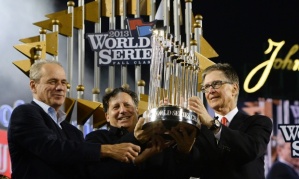
“I can’t give you a precise answer as to how many players will come and how many will go,” Lucchino said in an interview on Boston sports radio station WEEI. “We love the core of this team. We know the core of this team will be here and be with us. We know we have some new players who were signed for a couple of years, like Jonny Gomes and David Ross. So we do know that the core of this team will remain. But there’s absolutely no chance that the 25 guys who finished in the World Series will be the same 25 guys who will start Opening Day next year.”
Seven Red Sox players were among the 147 players who officially filed for free agency Thursday: catcher Jarrod Saltalamacchia, first baseman Mike Napoli, outfielder Jacoby Ellsbury, shortstop Stephen Drew, relief pitcher Joel Hanrahan, infielder John McDonald, and pitcher Alfredo Aceves, who was exiled to the minors last season.
Free agents can begin to sign with new teams beginning at 12:01 a.m. ET Tuesday. Until that time, they are not eligible to negotiate contract terms with a new team, although they and their representatives are allowed to talk with any team about a potential match. Teams retain exclusive negotiating rights with their free agents until that time.
But in the interim, the Sox must also decide whether they will extend a qualifying offer to their free agents, which determines whether they will receive draft-pick compensation if a free agent leaves.
Qualifying offers must be extended by 5 p.m. Monday. The value of a qualifying offer has been calculated by formula to be a one-year guarantee of $14.1 million for 2014. Any player accepting a qualifying offer is considered to be a signed player. A free agent has until 5 p.m. on Nov. 11 to accept a qualifying offer. If he declines a qualifying offer and signs with another big league team, his former team receives an amateur draft choice as compensation, while the signing team forfeits its highest available draft pick and the accompanying bonus pool money in the draft.
 What do you do with the left side of the infield? Shortstop Stephen Drew is a free agent and will be coveted in a market that features very little at the position. Because of that fact, he may be inclined to turn down any qualifying offer (one year, $14.1 million) the Red Sox give him and seek a long-term deal elsewhere. If that’s the case, Xander Bogaerts slides right on in, likely leaving Will Middlebrooks to man third base.
What do you do with the left side of the infield? Shortstop Stephen Drew is a free agent and will be coveted in a market that features very little at the position. Because of that fact, he may be inclined to turn down any qualifying offer (one year, $14.1 million) the Red Sox give him and seek a long-term deal elsewhere. If that’s the case, Xander Bogaerts slides right on in, likely leaving Will Middlebrooks to man third base.
But is that ideal for the Sox?
Middlebrooks’ up-and-down (but mostly down) 2013 campaign, coupled with a lackluster October, casts some doubt as to whether he is ready to be an everyday player in the majors. Meanwhile, Bogaerts looked like a 10-year veteran as the club’s third baseman in the World Series. Both he and the organization have said Bogaerts is a shortstop, but another year (at age 21) at the hot corner would not hinder his future at another position.
At the same age, Cal Ripken Jr. played the first half of his first full season at third base. Perhaps if the team finds a way to keep Drew, who doesn’t turn 31 until March, Bogaerts could do the same and Middlebrooks could be dealt or moved across the diamond to first base, if Mike Napoli moves on.
Will Salty return? Jarrod Saltalamacchia told ESPN prior to Game 6 that he had already wondered if he was spending his final few days as a Red Sox. David Ross, who is signed for next year, was John Farrell’s choice in the final three games of the World Series.
It seems as if we have been hearing his name forever, but Saltalamacchia is still just 28 and is coming off his best all-around offensive season (.273 average, 14 homers, .804 OPS). He fits in the clubhouse and with the pitching staff, and if the Sox see him continuing to improve defensively, a qualifying offer could be in the cards.
That could change if the organization feels that Ryan Lavarnway is ready enough to split time with Ross, or if it makes a push for someone like free agent Brian McCann. Prospect Blake Swihart could be knocking on the door in another year or so, and Christian Vazquez had a solid season at the plate and behind it at Double-A Portland, so more help is on the horizon.
 What’s the long-term future of Jon Lester? Boston will exercise its option for Lester for next year, which carries with it a $13 million price tag. His value is at an all-time high after a brilliant October (4-1 with a 1.56 ERA in five starts), and discussions of a long-term deal may be forthcoming. The Sox gave Josh Beckett and Clay Buchholz lengthy, pricy extensions in recent years. They also gave John Lackey a five-year, $82.5 million deal and Ryan Dempster a two-year, $26.5 million contract, then took on Jake Peavy’s $14.5 million salary for 2014. If there’s anything left over, locking up a durable, homegrown ace who is not yet 30 seems like a no-brainer.
What’s the long-term future of Jon Lester? Boston will exercise its option for Lester for next year, which carries with it a $13 million price tag. His value is at an all-time high after a brilliant October (4-1 with a 1.56 ERA in five starts), and discussions of a long-term deal may be forthcoming. The Sox gave Josh Beckett and Clay Buchholz lengthy, pricy extensions in recent years. They also gave John Lackey a five-year, $82.5 million deal and Ryan Dempster a two-year, $26.5 million contract, then took on Jake Peavy’s $14.5 million salary for 2014. If there’s anything left over, locking up a durable, homegrown ace who is not yet 30 seems like a no-brainer.
What about David Ortiz? While similar to Lester in some ways, the Ortiz situation is a little murkier. Many observers felt as if the organization had lost its mind when it gave the slugger, at the time 36 and rehabbing from an Achilles injury, a two-year deal that will now total $30 million due to an achieved incentive this year. When that contract expires after the 2014 season, would Ortiz — who would then be approaching 39 — seek one more multiyear deal elsewhere? And do the Sox want to prevent one of the cornerstones of their franchise from leaving?
As crazy as it seemed to lock him up last offseason, it would be awkward to let the World Series MVP go too far into the final year of his deal with an uncertain future. An extension beyond 2014 could be in his future.
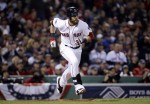 Bid adieu to Jacoby Ellsbury? There have been whispers for months that the two sides are far apart in negotiations. ESPN’s Buster Olney reported this week that a $30 million gap existed after Ellsbury’s phenomenal 2011 season and that the sides could not get together again after his down 2012. With Ellsbury a Scott Boras guy, the long-held assumption has been that the center fielder has been waiting to test the free-agent waters. Coming off a much better 2013 (.298 average, 52 steals) seems like a great time to do so.
Bid adieu to Jacoby Ellsbury? There have been whispers for months that the two sides are far apart in negotiations. ESPN’s Buster Olney reported this week that a $30 million gap existed after Ellsbury’s phenomenal 2011 season and that the sides could not get together again after his down 2012. With Ellsbury a Scott Boras guy, the long-held assumption has been that the center fielder has been waiting to test the free-agent waters. Coming off a much better 2013 (.298 average, 52 steals) seems like a great time to do so.
Boston’s aggressiveness in this matter rests largely in its opinion of Jackie Bradley Jr. The youngster had a rough time in his first stint in the big leagues in April but looked a bit more comfortable in his Red Sox skin once he was called up again in September, even getting support from some to be included on the postseason roster.
Bradley will not disappoint in the field; he has range and a great arm. Enduring some growing pains at the plate would hurt much less than paying Ellsbury upward of $18 million when he is 36 and beginning to break down. Not saying that would necessarily happen, but it’s the risk you run with big-money long-term deals, and Bradley will come at a pittance as he approaches his prime.
Who’s on the bench? The 2013 Red Sox did not have many holes. However, there were times when it felt as if they needed one more utility guy in the infield. Brock Holt and Brandon Snyder did not impress in their brief stints, and once Jose Iglesias left, there was a relative lack of options some nights if one of the starters went down.
To illustrate the conundrum, Middlebrooks stood as Dustin Pedroia’s backup for a handful of games. Veteran John McDonald was brought in late to add an extra hand, and Bogaerts’ call-up gave the club another option, but the organization would do well to bring in an Alex Cora-type who can ably back up multiple spots. Someone with speed who can play center would help even more if Ellsbury leaves and Bradley needs a backup.
 Lester-Buchholz-Lackey-Peavy-? Pencil in Lester, Buchholz, Lackey and Peavy as the top four starters. Who gets the No. 5 spot? Felix Doubront made strides in 2013 and figures to have earned it, but Dempster is on the books for $13.25 million. Also, waiting in the wings are a few young, intriguing arms who could make a push, including Allen Webster and Anthony Ranaudo.
Lester-Buchholz-Lackey-Peavy-? Pencil in Lester, Buchholz, Lackey and Peavy as the top four starters. Who gets the No. 5 spot? Felix Doubront made strides in 2013 and figures to have earned it, but Dempster is on the books for $13.25 million. Also, waiting in the wings are a few young, intriguing arms who could make a push, including Allen Webster and Anthony Ranaudo.
Chances are Doubront gets a spot, Dempster serves as an expensive long man/spot starter, a la Tim Wakefield late in his career, or gets traded, and the youngsters are given more time to prepare for when somebody goes down.
And somebody will go down.

The Sox were actually quite fortunate to suffer only one long-term injury among starters, that being Buchholz’s three-month absence. There will be injuries, and having the depth to atone for them is as important as anything through the course of a long season.
 Bring back Nap? “I want to be here. I love this place.”
Bring back Nap? “I want to be here. I love this place.”
That was Mike Napoli after the World Series triumph. Lines like that one are thrown around like empty beer cans during such celebrations, but it is clear that Napoli has been a nice fit in Boston.
Napoli’s agent told the Boston Globe that his client would not accept another one-year deal, and that the club would analyze the condition of Napoli’s hips to see if there has been any significant wear and tear since the last checkup. With a clean bill of health, perhaps something like the three-year, $39-million deal that the two sides reportedly agreed on last offseason — before the discovery of the hip condition altered things — could become a reality. Napoli agreed to a $5 million base salary for 2013 but earned the full $13 million with incentives.
The Sox will likely make a qualifying offer to Napoli and receive a draft pick if he elects to move on, but expect the man who ranked second on the team in home runs (23) and RBIs (92), and who surprised some with a quality showing at first base, to return.
The easy decisions on making qualifying offers include Ellsbury, who is expected to be one of the most highly sought free agents on the market, and Napoli, one of the few power bats available on the market. Neither is likely to accept a qualifying offer, given the certainty of receiving multi-year offers from multiple teams.
McDonald and Aceves, whose value falls far below the $14.1 million qualifying mark, will not receive qualifying offers. The Sox also will not tender a qualifying offer to Hanrahan, who said in October he had just begun throwing 60 feet and will not be ready for the start of the season after undergoing reconstructive elbow surgery in May.
That leaves two players, shortstop Drew and catcher Saltalamacchia. First, Saltalamacchia: At 28, he is the youngest catcher on the free-agent list, and unless the Sox decide to go all-in on free agent Brian McCann, a qualifying offer makes sense, which would buy some time while prospects like Blake Swihart and Christian Vazquez develop, yet spare them from a long-term commitment. It also would assure them of draft-pick compensation if Salty leaves. Drew is also one of the better options in a light shortstop market, and while the Sox have his replacement in the wings in Xander Bogaerts, there would seem to be little downside to extending a qualifying offer.
Will the coaching staff remain intact? Those who toiled under Farrell received loads of credit this year, particularly Juan Nieves for his work in turning around the pitching staff, Brian Butterfield for his defensive genius and Torey Lovullo for his overall work in helping to create the most complete team in all of baseball.
Lovullo is being linked to the Chicago Cubs’ managerial vacancy. Cubs president Theo Epstein is obviously familiar with Lovullo, who has interviewed for jobs in the past. Farrell said earlier in the World Series that he expects Lovullo, and others, to get their shots.
Farrell and Butterfield worked together in Toronto, and Butterfield was brought over after Farrell got the managerial job in Boston. He has also interviewed for vacancies, but perhaps these two will establish something like the Terry Francona-Brad Mills partnership that survived many years in Boston and was rekindled this season in Cleveland.
On Nov. 11, the general managers’ meetings begin in Orlando, where talks about potential trades often percolate, with the winter meetings following a month later, also in Orlando.
Shane Victorino still out – Lineup Shuffled for Game 5
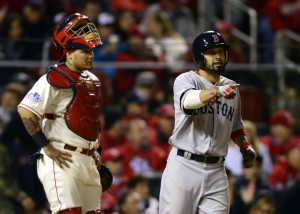 Boston Red Sox outfielder Shane Victorino was not in the starting lineup for Monday night’s Game 5 of the World Series against the St. Louis Cardinals, marking the second straight game he’ll be sidelined with lower-back tightness, though manager John Farrell has since noted “The Flyin’ Hawaiian” will be should be available off the bench.
Boston Red Sox outfielder Shane Victorino was not in the starting lineup for Monday night’s Game 5 of the World Series against the St. Louis Cardinals, marking the second straight game he’ll be sidelined with lower-back tightness, though manager John Farrell has since noted “The Flyin’ Hawaiian” will be should be available off the bench.
Jonny Gomes will again take his spot in the lineup playing left field, with Daniel Nava moving to Victorino’s place in right field.
The Red Sox also shuffled their lineup a bit, moving Dustin Pedroia from the third spot to second and David Ortiz from fourth to third. Game 4 hero Gomes will hit cleanup, followed by Nava.
David Ross will be behind the plate for the second straight game.
RED SOX LINEUP
1. Jacoby Ellsbury, CF
2. Dustin Pedroia, 2B
3. David Ortiz, 1B
4. Jonny Gomes, LF
5. Daniel Nava, RF
6. Xander Bogaerts, 3B
7. Stephen Drew, SS
8. David Ross, C
9. Jon Lester, SP
Game 5, Like Deja Vu all over again
• Starting pitchers: Adam Wainwright (19-9, 2.94 ERA) vs. Jon Lester (15-8, 3.75 ERA)
• Scouting report on Wainwright: Not much went right for Wainwright in Game 1 against the Red Sox. A seven-pitch walk to Jacoby Ellsbury in the first was only the start of the 32-year-old’s rough night as he allowed three runs in the opening inning, partly due to poor defensive play behind him. However, with the series tied 2-2, Wainwright has another crack at giving his team the advantage moving forward.
“It’s a pretty clean slate [from my last start],” Wainwright said Sunday in his news conference at Busch Stadium. “I honestly don’t know why my mechanics were as bad as they were [and] my delivery was off as much as it was. But I feel like I’ve put a lot of good reps in in front of the mirror and watching film and feeling my delivery again.”
“I feel like I’ve made a lot of good adjustments to be ready for this next game to throw some quality pitches.”
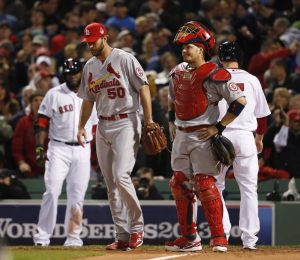 In his Game 1 start, Wainwright’s curveball was his best pitch. He used his curveball for 15 of his final 33 pitches, a span that saw him retire seven straight batters before allowing a David Ortiz single in the fifth inning that he was able to pitch around. Overall, Wainwright went five innings, allowing five runs (three earned) on six hits and striking out four.
In his Game 1 start, Wainwright’s curveball was his best pitch. He used his curveball for 15 of his final 33 pitches, a span that saw him retire seven straight batters before allowing a David Ortiz single in the fifth inning that he was able to pitch around. Overall, Wainwright went five innings, allowing five runs (three earned) on six hits and striking out four.
“I learned that they hit mistakes,” Wainwright said of his first career start against Boston last Wednesday. “And I learned that if I make mistakes in the middle of the plate up in the zone, they’re going to hit them.”
Overall, Wainwright is 2-2 in his four postseason starts with a 2.25 ERA. The right-hander has allowed seven runs (five earned) in his past 12 innings after allowing only two runs in his first 16 innings pitched of the playoffs.
• Scouting report on Lester: Putting aside the speculation that he was in some way doctoring his pitches in Game 1, Lester pitched masterfully, shutting out the Cardinals’ potent offense for 7 2/3 innings and striking out eight batters. The start was yet another in a string of successful starts Lester has made in October, something he says he doesn’t know how to explain.
“I feel like I’ve pitched pretty [well] throughout most of my seasons, and it’s just carried over into the postseason,” Lester said Sunday. “I don’t know what it is. I like this stage. I like knowing that I’ve got to go out there and give everything I’ve got for my teammates, because tomorrow might be our last game. You don’t know; I guess that just gives you that little extra focus.”
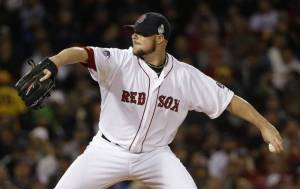 Of Lester’s 10 career postseason starts, seven have been of the quality variety — at least six innings pitched and three runs or fewer allowed. The 29-year-old has gone 5-4 in 12 postseason appearances overall, posting a 2.22 ERA. Of his 69 postseason innings pitched, 13 1/3 have come in the World Series, where he has yet to allow a run.
Of Lester’s 10 career postseason starts, seven have been of the quality variety — at least six innings pitched and three runs or fewer allowed. The 29-year-old has gone 5-4 in 12 postseason appearances overall, posting a 2.22 ERA. Of his 69 postseason innings pitched, 13 1/3 have come in the World Series, where he has yet to allow a run.
“I think the one thing that we all recognize is that the power stuff wins in the postseason,” Red Sox manager John Farrell said Sunday. “He’s got it, he maintains it, and yet, in addition to his physical strengths, there’s a level of concentration that he’s capable of maintaining that gives him the ability to execute consistently over the time he’s on the mound. Those two things combined are what’s given [him] the career performance he’s had in the postseason.”
This will be the first time in his career that Lester has made five starts in a single postseason.
Three Cardinals players to watch
• Carlos Beltran, RF: Beltran was only given one shot at Lester in Game 1, striking out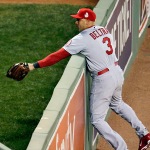 swinging on four pitches before being removed from the game due to a rib contusion. Beltran has three hits in 10 World Series at-bats so far, two of which have come in his two at-bats with runners in scoring position. Beltran was left with a bat in his hand at home plate in the ninth inning of Game 4 after Kolten Wong was picked off first base to end the game.
swinging on four pitches before being removed from the game due to a rib contusion. Beltran has three hits in 10 World Series at-bats so far, two of which have come in his two at-bats with runners in scoring position. Beltran was left with a bat in his hand at home plate in the ninth inning of Game 4 after Kolten Wong was picked off first base to end the game.
• David Freese, 3B: Since singling in the ninth inning of Game 1, Freese has been held hitless in his past eight at-bats, a streak that’s resulted in him being dropped to seventh in the order. Of the 13 runners he’s left on base the past four games, six have been left in scoring position.
• Pete Kozma, SS: In keeping with pattern, manager Mike Matheny has selected Kozma to start at short in Games 1 and 3 while going with Daniel Descalso in Games 2 and 4. The difference between the two has been a wash offensively, as Descalso is 0-for-6 while Kozma is 0-for-8 through the first four games of the series. However, Kozma was the only St. Louis Cardinals hitter to not strike out in Game 1, seeing 13 pitches in his three plate appearances.
Three Red Sox players to watch
• David Ortiz, 1B: A lot of the talk leading into the World Series was about how many games Ortiz would play at first base over Mike Napoli. But Ortiz has ended that conversation, with a gaudy .727 batting average, a result of eight hits in 11 at-bats. His eight hits have accounted for a third of the Red Sox’s total in the series (24). He also has two of Boston’s three homers and he leads the team in RBI (5) and runs (5). He has collected hits in his past four at-bats and is the only Boston starter to not strike out so far.
games Ortiz would play at first base over Mike Napoli. But Ortiz has ended that conversation, with a gaudy .727 batting average, a result of eight hits in 11 at-bats. His eight hits have accounted for a third of the Red Sox’s total in the series (24). He also has two of Boston’s three homers and he leads the team in RBI (5) and runs (5). He has collected hits in his past four at-bats and is the only Boston starter to not strike out so far.
• Jonny Gomes, LF: With outfielder Shane Victorino’s status still unknown following his late scratch before Game 4, Gomes re-proved his worth in the lineup to Farrell by hitting what turned out to be the game-winning three-run home run for Boston in the sixth inning, ending his 0-for-9 skid to start the World Series. Gomes also worked a 10-pitch walk in the fifth and a six-pitch walk in the eighth inning of Sunday’s game, a step back on the right track for a player with whom Boston has won eight of nine postseason starts.
• Xander Bogaerts, 3B: Bogaerts started off the series going 0-for-6 with four strikeouts in Games 1 and 2 before turning it on in St. Louis to collect three hits in his past seven at-bats. The 21-year-old’s .231 average is third on the team behind Ortiz (.727) and Dustin Pedroia (.267).
Three key considerations:
• Red Sox reliever Junichi Tazawa has appeared in all four World Series games, the only pitcher on either team to do so. Farrell has used Tazawa to face just one batter in three of his four appearances, something the 27-year-old did in only two of his 71 appearances during the regular season.
• Sunday night’s win guaranteed that the series will shift back to Fenway Park for at least a Game 6. So far this postseason, Boston is 5-2 at home compared to 4-3 on the road.
• David Ross will be back behind the plate in Game 5, according to Farrell. Ross has  caught all four of Lester’s starts this postseason, including Game 1 where he went 1-for-2 against Wainwright. It will be Ross’s second consecutive start since regular starter Jarrod Saltalamacchia made a throw that led to the obstruction call that ended Game 3.
caught all four of Lester’s starts this postseason, including Game 1 where he went 1-for-2 against Wainwright. It will be Ross’s second consecutive start since regular starter Jarrod Saltalamacchia made a throw that led to the obstruction call that ended Game 3.
